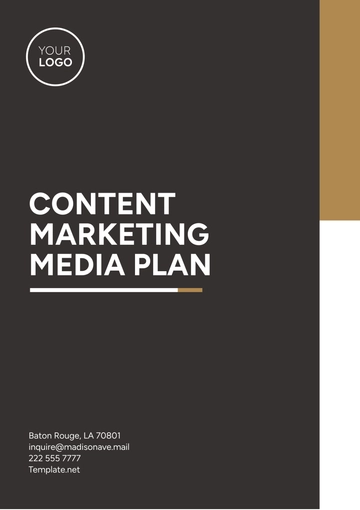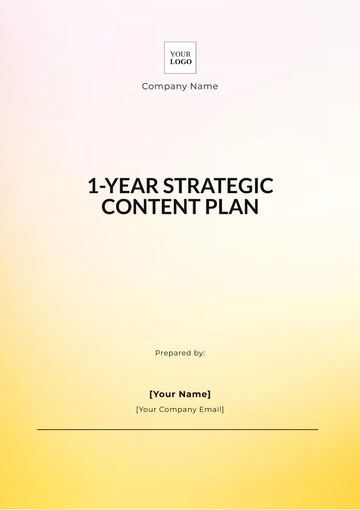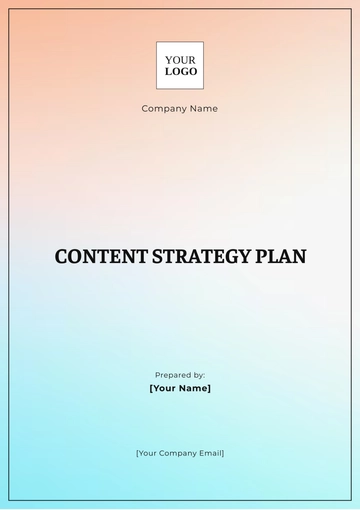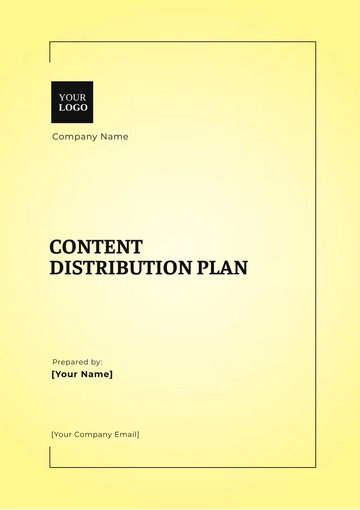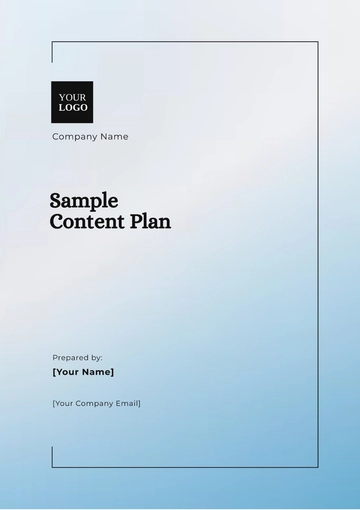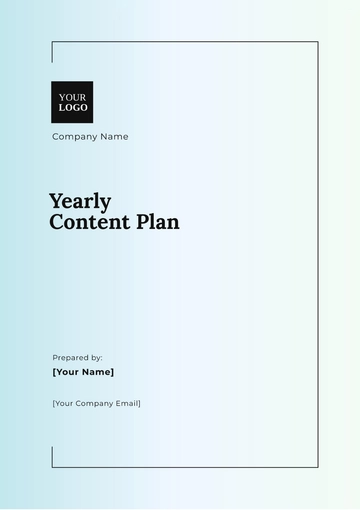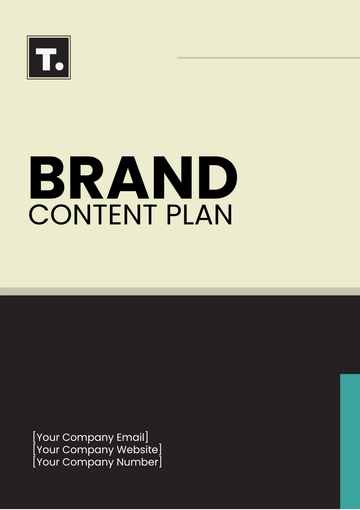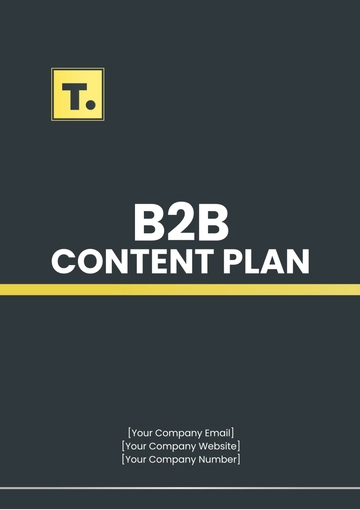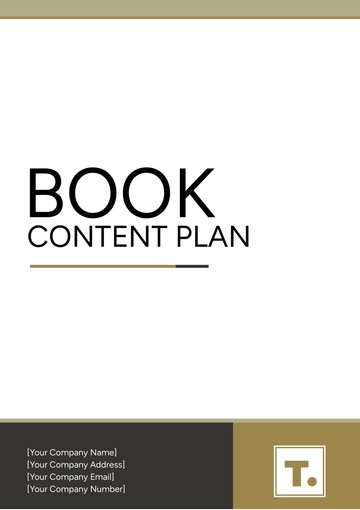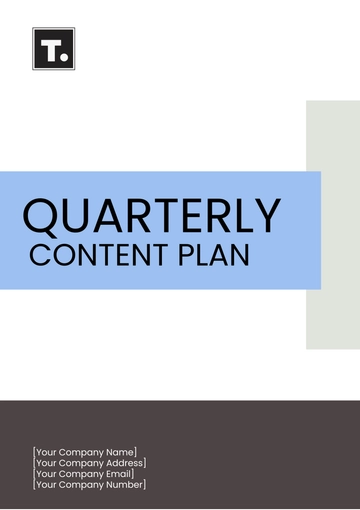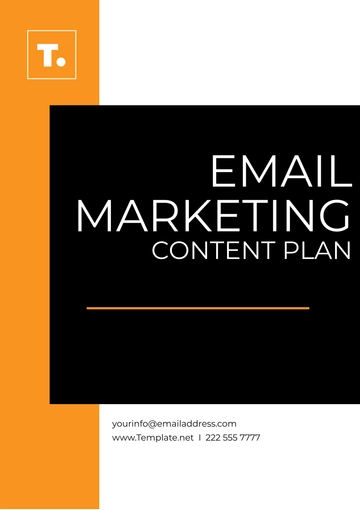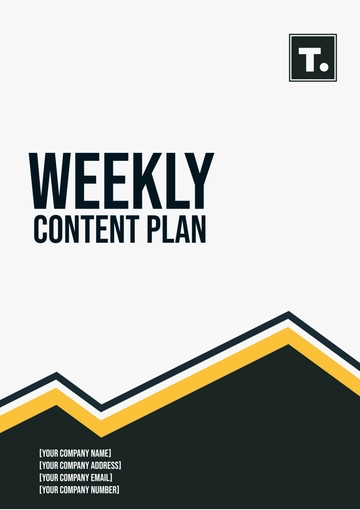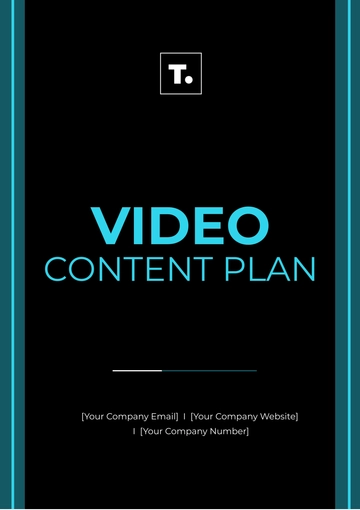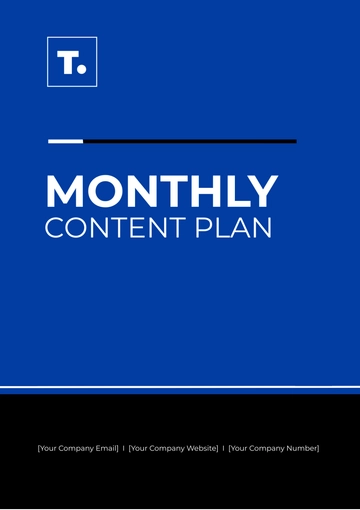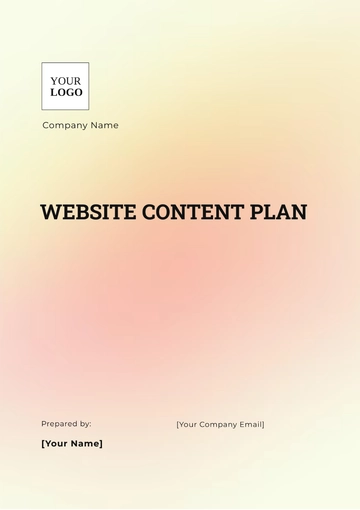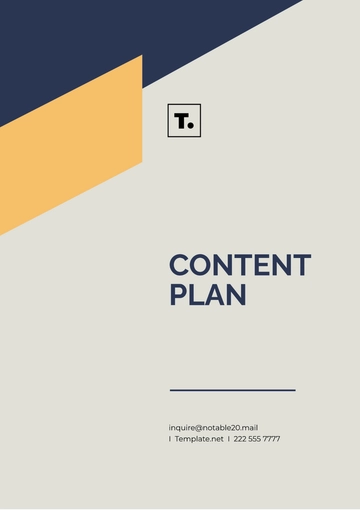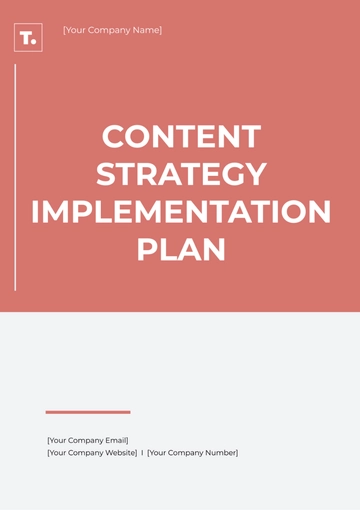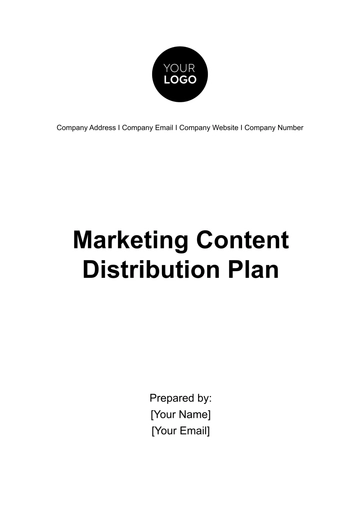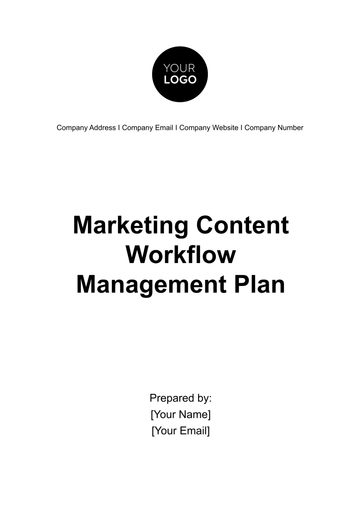Free Marketing Content Distribution Plan
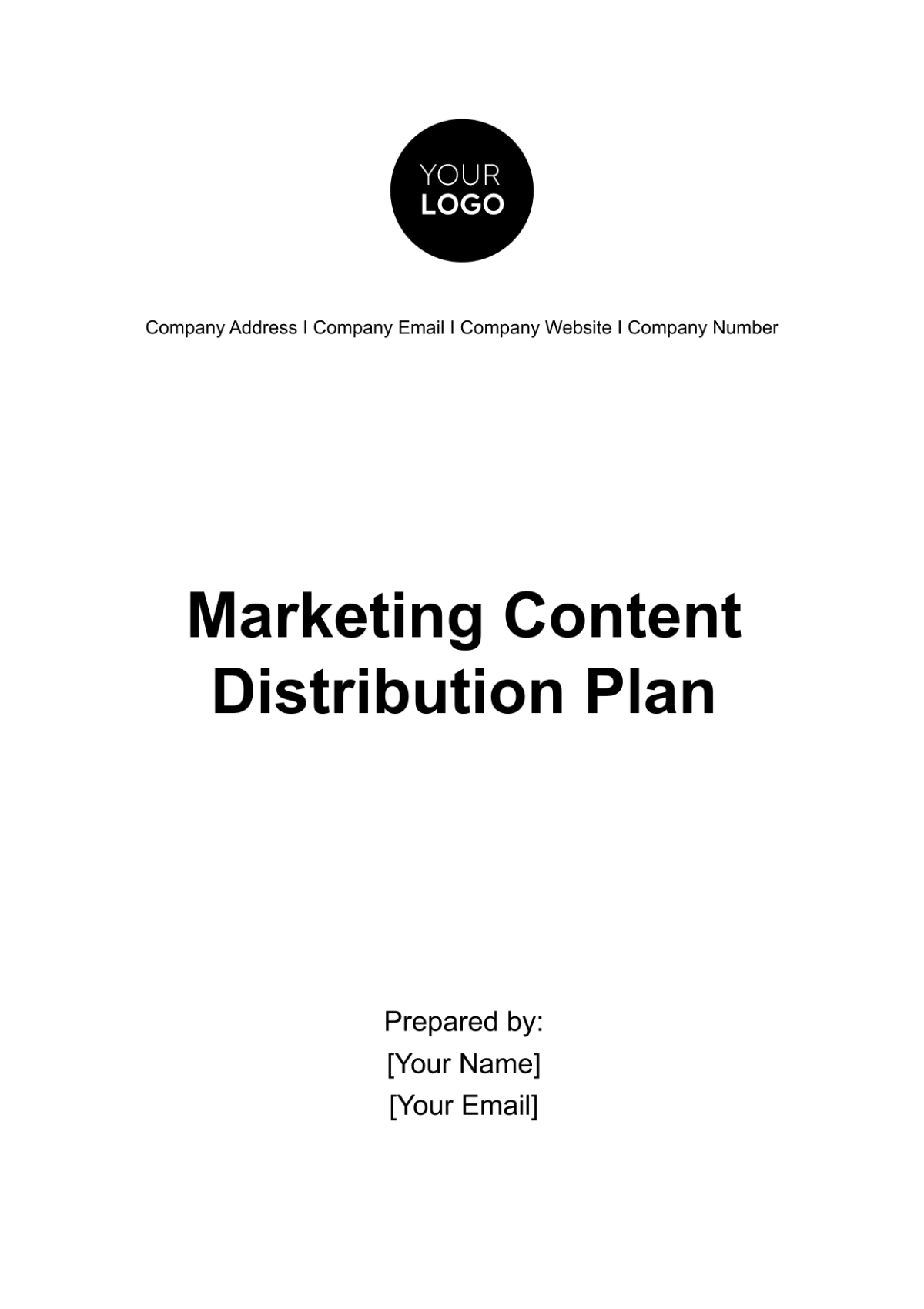
1. Executive Summary
The Executive Summary provides an overview of the Marketing Content Distribution Plan crafted specifically for [Company Name]. The primary goal of this plan is to align and streamline the company's marketing efforts across a range of diverse channels. By doing so, we aim to reach our target audience with maximum impact, driving both engagement and conversions. This strategy hinges on the effective distribution of various types of content, such as blog posts, social media posts, email newsletters, videos, and podcasts. Not only does the plan detail what kinds of content will be disseminated, but it also specifies where and when this content will be shared, ensuring optimized timing and platform-specific tailoring. This multi-faceted approach is intended to not just reach but resonate with our target audience, thereby achieving our marketing objectives, which range from increasing brand awareness to driving website traffic and enhancing conversion rates.
2. Objectives
The objectives section outlines the key goals that [Company Name] aims to achieve through the implementation of this Marketing Content Distribution Plan. These objectives are both quantitative and strategic, providing clear targets that will guide our efforts and enable us to measure the success of our marketing initiatives. Below are the specific objectives:
To Increase Brand Awareness by 25% in Q4. Increasing brand awareness is paramount for expanding our customer base and enhancing market position. By setting a target increase of 25% in the fourth quarter, we are committing to strategic content dissemination that will place [Your Company Name] at the forefront of our audience’s mind. This will be achieved through a well-orchestrated blend of social media marketing, public relations campaigns, and influencer partnerships.
To Drive a 15% Increase in Website Traffic Through Content Marketing. Website traffic serves as a critical indicator of our online visibility and the effectiveness of our content marketing strategy. A 15% increase in website traffic will not only boost brand awareness but also provide more opportunities for conversion. To achieve this, we will focus on Search Engine Optimization (SEO) and share high-quality, relevant content through various platforms including blogs, social media, and email newsletters.
To Achieve a 10% Conversion Rate from Content Marketing Channels. Conversion rate is the ultimate measure of the effectiveness of any marketing strategy. A target of 10% conversion rate implies that we aim to ensure that 1 out of every 10 interactions through our content marketing channels leads to a desired action, such as a sale, a sign-up, or another form of engagement. To reach this goal, our content will not just aim to inform or entertain, but also to drive action through strong calls-to-action, customer testimonials, and limited-time offers.
By focusing on these objectives, [Company Name] aims to create a holistic and effective content marketing strategy that drives both visibility and tangible results.
3. Target Audience
Understanding the target audience is fundamental to crafting a successful Marketing Content Distribution Plan. The more we know about who we are reaching, the better we can tailor our messages and choose the appropriate channels for distribution. Below are the specific demographics of our intended target audience:
Age Group: 25-40
Our primary focus will be on the age group of 25 to 40 years old. This age bracket generally has a more stable financial status, enabling them to engage with our product or service more feasibly. Moreover, this group is often tech-savvy and comfortable navigating through various digital platforms where most of our content will be distributed. Tailoring our content to resonate with this age group will improve the chances of higher engagement and conversion rates.
Gender: 40% Male, 60% Female
While our products or services appeal to a broad audience, statistics show a slightly higher engagement rate among females. We expect our target audience to be 40% male and 60% female. This gender ratio will influence the kind of content we create, ensuring that it resonates with the slightly female-skewed audience without alienating male customers.
Geographical Locations: New York, San Francisco, London
Geographically, our focus will be on the urban centers of New York, San Francisco, and London. These cities are hubs for our target age group and offer higher rates of digital engagement compared to other locations. Moreover, they are culturally diverse and economically stable, providing a ripe market for our offerings. We will tailor our content to suit the cultural and consumer trends prevalent in these cities, ensuring a higher rate of local engagement.
By meticulously defining our target audience, we can make data-driven decisions that influence the content creation and distribution strategies, ensuring that we reach the right people at the right time with the most compelling messages.
4. Content Types
The types of content we choose to produce and distribute play a critical role in the overall effectiveness of our Marketing Content Distribution Plan. Different formats resonate with different audiences and are more or less suited to various kinds of messaging. In this section, we outline the various types of content that [Company Name] will utilize to achieve its marketing objectives.
Blog Posts. Blog posts offer an excellent platform for diving deep into topics that are relevant to our industry and target audience. They are also invaluable for SEO, helping to drive organic search traffic to our website. We aim to publish bi-weekly blog posts that provide useful information, insights, or solutions to problems commonly faced by our target demographic. These posts will be promoted across social media channels and through email newsletters to maximize reach.
Social Media Posts. Social media offers a more immediate and interactive way to engage with our audience. Through platforms such as Facebook, Instagram, and Twitter, we can share timely updates, promotional content, and even provide customer service. Social media posts will be a mix of video, image, and text-based content, carefully curated to engage our audience and encourage sharing.
Email Newsletters. Email remains one of the most effective channels for direct communication with our customer base. We will send out monthly newsletters containing a roundup of our latest blog posts, news, and promotions. The aim is to keep [Company Name] top-of-mind for our subscribers and to provide them with valuable content that they look forward to receiving.
Videos. Videos are increasingly becoming the content type of choice for many consumers, especially in the age group we are targeting. They offer an engaging way to deliver a lot of information quickly and entertainingly. We will produce videos for product demonstrations, customer testimonials, and informational content, distributing them through social media and embedding them in our blog posts and email newsletters.
Podcasts. Podcasts have seen a rise in popularity and offer a unique channel to reach our target demographic, especially those who prefer audio content that they can consume on-the-go. We will launch a bi-monthly podcast series focusing on topics that resonate with our audience, featuring guest interviews with industry experts and influencers to enhance credibility and listener engagement.
By leveraging these diverse content types, [Your Company Name] aims to create a rich tapestry of engaging materials that will resonate with our target audience, thereby driving engagement, traffic, and conversions.
5. Distribution Channels
In order to maximize the impact of our varied content types, it is essential to identify the most effective platforms for distribution. Distributing content through the appropriate channels ensures that it reaches the intended target audience and accomplishes the objectives set forth in our Marketing Content Distribution Plan. This chapter outlines the primary, secondary, and tertiary channels we have identified for disseminating each type of content, ensuring that we exploit the full range of opportunities available to connect with our audience.
The table below provides a detailed breakdown:
Content Type | Primary Channel | Secondary Channel | Tertiary Channel |
Blog Posts | Company Website | Email Newsletter | |
Social Media Posts | |||
Email Newsletters | Email list | N/A | N/A |
Videos | YouTube | Instagram Reels | Company Website |
Podcasts | Apple Podcast | Spotify | Company Website |
By strategically allocating our content across these channels, we aim to make the most of each platform's unique features and audience demographics, thereby optimizing reach and engagement.
6. Distribution Calendar
Effective content distribution isn't just about what you share; it's also about when and where you share it. Timing can be crucial, especially in an age where information is abundant and attention spans are short. The Distribution Calendar serves as a structured timeline that outlines when each piece of content will be published and through which channels. This calendar also specifies the person responsible for each distribution task, ensuring accountability and smooth execution of the marketing plan.
Below is a snapshot of how the Distribution Calendar is organized:
Date | Content Type | Channel | Responsible Person |
[Date] | Blog Post | Company Website | [Person 1] |
[Date] | Video | YouTube | [Person 2] |
[Date] | Email Newsletter | Email List | [Person 3] |
By adhering to a well-planned Distribution Calendar, [Company Name] aims to ensure that its content not only reaches the target audience but also does so at a time that maximizes engagement and potential for conversion.
7. Metrics and KPIs
Success in any marketing initiative is deeply intertwined with the ability to measure and analyze performance. This is particularly true for a comprehensive Marketing Content Distribution Plan, where resources are invested across multiple channels and content types. This chapter focuses on the key performance indicators (KPIs) and metrics that [Company Name] will use to evaluate the success of its marketing efforts. By closely monitoring these metrics, we can make data-driven decisions to optimize future strategies.
Website Traffic. Website traffic is a primary indicator of how well our content is attracting an audience. By monitoring metrics like page views, unique visitors, and time spent on site, we can gain insights into the reach and effectiveness of our content. This data will also help us understand which channels are most effective at driving traffic, allowing us to allocate resources more efficiently.
Engagement Rate. Engagement rate measures how actively audiences are interacting with our content. This includes likes, shares, comments, and other forms of social interaction across platforms. A higher engagement rate often signals content relevance and quality, which are critical for brand image and credibility. We will track engagement rate for each content type across all distribution channels to understand what resonates most with our audience.
Conversion Rate. The conversion rate reflects the percentage of visitors who take a desired action after interacting with our content, such as making a purchase, signing up for a newsletter, or filling out a contact form. Monitoring the conversion rate will help us understand the direct impact of our content on business objectives and will serve as a vital performance indicator for return on investment.
Click-through Rate (CTR). Click-through rate is the ratio of users who click on a specific link relative to the total number of users who view the content. This is crucial for measuring the effectiveness of online advertising campaigns and email marketing initiatives. A high CTR is usually indicative of a well-targeted message or a compelling call-to-action, both of which are key goals for our content distribution strategy.
Return on Investment (ROI). ROI is the ultimate measure of the financial effectiveness of our marketing efforts. By calculating the return on investment for our content marketing activities, we can assess their value in tangible terms. ROI will be measured by comparing the revenue generated from content marketing activities to the costs involved in creating and distributing the content.
By regularly tracking and analyzing these metrics and KPIs, [Company Name] aims to continuously refine its Marketing Content Distribution Plan for maximum effectiveness and profitability.
8. Budget
Allocating resources efficiently is a cornerstone of any successful marketing campaign. Financial planning and budgeting play a critical role in ensuring that each facet of our Marketing Content Distribution Plan is not just feasible, but also cost-effective. This chapter provides a detailed overview of the estimated costs associated with distributing content across various channels. It aims to offer stakeholders a comprehensive understanding of the financial commitment required to execute this plan successfully.
Distribution Channel | Estimated Cost |
Company Website | $1,000 |
Social Media | $1,500 |
Email Marketing | $700 |
These cost estimates are designed to align with the objectives and KPIs set out in the earlier sections of this plan. The budget has been developed to ensure that each dollar spent contributes meaningfully towards achieving our strategic goals, ultimately offering the best possible return on investment.
9. Risks and Contingencies
No marketing plan is complete without accounting for potential risks and preparing for unforeseen challenges. While this Marketing Content Distribution Plan has been carefully designed to maximize reach and engagement, it's crucial to acknowledge that variables outside of our control may affect its success. This chapter outlines the primary risks associated with this plan and the contingency measures in place to mitigate them.
Risk of Low Engagement. One of the significant risks we face is that the content may not resonate with the target audience, resulting in lower-than-expected engagement rates. This is a critical concern because low engagement could lead to a reduced ROI and could impact our brand's reputation. Should we encounter such a scenario, we have a contingency plan in place to recalibrate our approach. This plan involves conducting a thorough analysis to identify the root cause of the low engagement. It could be an issue with the content itself, the timing of the distribution, or even the channels used. Based on this analysis, we would adjust our strategy to focus more on the channels that are showing the best performance. This might involve reallocating resources, revising the types of content produced, or even changing the target audience focus.
By acknowledging these risks upfront and preparing contingency plans, we aim to be agile and responsive, adapting our strategy as needed to ensure the overall success of [Company Name]'s marketing efforts.
_____________________________________________________________________________________
For more information, contact [Contact Details].
Prepared by: [Your Name]
Date: [Current Date]
_____________________________________________________________________________________
This Marketing Content Distribution Plan serves as a comprehensive roadmap for [Your Company Name] to effectively reach its target audience and achieve its objectives.
- 100% Customizable, free editor
- Access 1 Million+ Templates, photo’s & graphics
- Download or share as a template
- Click and replace photos, graphics, text, backgrounds
- Resize, crop, AI write & more
- Access advanced editor
Introducing the Marketing Content Distribution Plan Template from Template.net! This customizable and editable tool streamlines your content distribution strategy. Craft tailored plans effortlessly with our AI Editor Tool, ensuring maximum reach and engagement. Stay ahead of the digital landscape with this essential resource. Optimize your distribution strategy now!
You may also like
- Finance Plan
- Construction Plan
- Sales Plan
- Development Plan
- Career Plan
- Budget Plan
- HR Plan
- Education Plan
- Transition Plan
- Work Plan
- Training Plan
- Communication Plan
- Operation Plan
- Health And Safety Plan
- Strategy Plan
- Professional Development Plan
- Advertising Plan
- Risk Management Plan
- Restaurant Plan
- School Plan
- Nursing Home Patient Care Plan
- Nursing Care Plan
- Plan Event
- Startup Plan
- Social Media Plan
- Staffing Plan
- Annual Plan
- Content Plan
- Payment Plan
- Implementation Plan
- Hotel Plan
- Workout Plan
- Accounting Plan
- Campaign Plan
- Essay Plan
- 30 60 90 Day Plan
- Research Plan
- Recruitment Plan
- 90 Day Plan
- Quarterly Plan
- Emergency Plan
- 5 Year Plan
- Gym Plan
- Personal Plan
- IT and Software Plan
- Treatment Plan
- Real Estate Plan
- Law Firm Plan
- Healthcare Plan
- Improvement Plan
- Media Plan
- 5 Year Business Plan
- Learning Plan
- Marketing Campaign Plan
- Travel Agency Plan
- Cleaning Services Plan
- Interior Design Plan
- Performance Plan
- PR Plan
- Birth Plan
- Life Plan
- SEO Plan
- Disaster Recovery Plan
- Continuity Plan
- Launch Plan
- Legal Plan
- Behavior Plan
- Performance Improvement Plan
- Salon Plan
- Security Plan
- Security Management Plan
- Employee Development Plan
- Quality Plan
- Service Improvement Plan
- Growth Plan
- Incident Response Plan
- Basketball Plan
- Emergency Action Plan
- Product Launch Plan
- Spa Plan
- Employee Training Plan
- Data Analysis Plan
- Employee Action Plan
- Territory Plan
- Audit Plan
- Classroom Plan
- Activity Plan
- Parenting Plan
- Care Plan
- Project Execution Plan
- Exercise Plan
- Internship Plan
- Software Development Plan
- Continuous Improvement Plan
- Leave Plan
- 90 Day Sales Plan
- Advertising Agency Plan
- Employee Transition Plan
- Smart Action Plan
- Workplace Safety Plan
- Behavior Change Plan
- Contingency Plan
- Continuity of Operations Plan
- Health Plan
- Quality Control Plan
- Self Plan
- Sports Development Plan
- Change Management Plan
- Ecommerce Plan
- Personal Financial Plan
- Process Improvement Plan
- 30-60-90 Day Sales Plan
- Crisis Management Plan
- Engagement Plan
- Execution Plan
- Pandemic Plan
- Quality Assurance Plan
- Service Continuity Plan
- Agile Project Plan
- Fundraising Plan
- Job Transition Plan
- Asset Maintenance Plan
- Maintenance Plan
- Software Test Plan
- Staff Training and Development Plan
- 3 Year Plan
- Brand Activation Plan
- Release Plan
- Resource Plan
- Risk Mitigation Plan
- Teacher Plan
- 30 60 90 Day Plan for New Manager
- Food Safety Plan
- Food Truck Plan
- Hiring Plan
- Quality Management Plan
- Wellness Plan
- Behavior Intervention Plan
- Bonus Plan
- Investment Plan
- Maternity Leave Plan
- Pandemic Response Plan
- Succession Planning
- Coaching Plan
- Configuration Management Plan
- Remote Work Plan
- Self Care Plan
- Teaching Plan
- 100-Day Plan
- HACCP Plan
- Student Plan
- Sustainability Plan
- 30 60 90 Day Plan for Interview
- Access Plan
- Site Specific Safety Plan
